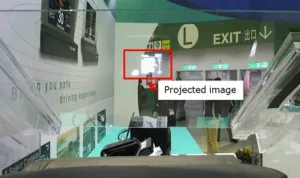Taiwan’s E-Lead Electronics has developed a low-cost automotive HUD, showing it at the Taipei AMPA & AutoTronics show earlier this month.
In-car HUDs usually take the form of a dedicated transparent display (‘combiner type’) or a windscreen and projector combination (‘windscreen type’); information is projected onto these displays. Another form factor uses projectors and mirrors to reflect an image onto the windscreen (‘LED/TFT direct-reflection type’).
A windscreen-type HUD has several advantages; a driver does not have to move his or her eyes much and can see projected images at a longer distance. However, they require a special windscreen, which is expensive.
Image credit: NikkeiRather than following these products, E-Lead has developed an optical film that can be applied to the windscreen of a car and reflect a projected image. It is thought that, compared to using a special windscreen, costs could be cut by up to 90%. The projector is installed in the dashboard or on the back of the rear-view mirror.
E-Lead says that the film has a 90% transmittance. A projected image is viewed from a perceived distance of 2m – 3m. The total cost for the new HUD device would be between $300 and $400, said E-Lead. Commercialisation is planned to take place this year.
Comment
MIT developed a similar system early last year (Display Monitor Vol 21 No 4), which used nanoparticles to reflect specific wavelengths of light. (TA)

